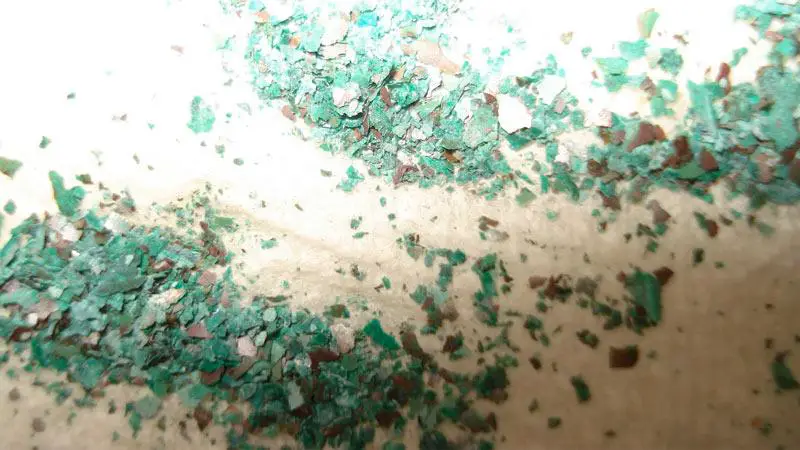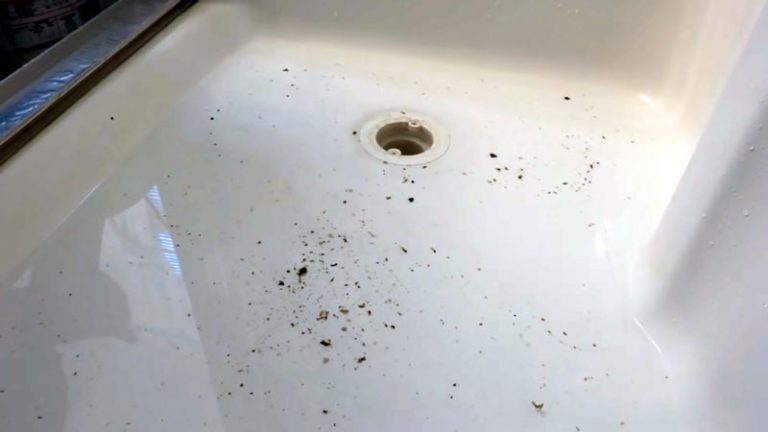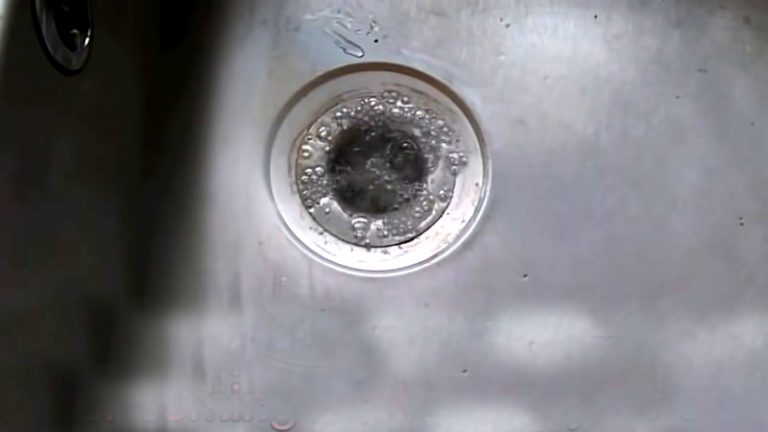Why there is Blue/Green Flakes in Water?

Blue or green flakes in water can be harmful to your health because they may indicate excessive levels of copper in your home’s water. Copper is a toxic substance and can cause vomiting, diarrhea, nausea, and higher risks of liver problems and kidney disease. The copper may be coming from corroded copper pipes, and it is important to test the water and contact a professional plumber if you suspect high levels of copper in your water.
You'll Learn About
Why there is Blue/Green Flakes in Water?
Blue or green flakes in water may indicate the presence of excessive levels of copper. Copper is a naturally occurring metal that is essential for human health in small amounts, but can be toxic if consumed in large quantities. Copper is commonly used in plumbing because it is resistant to corrosion and relatively inexpensive.
However, over time, copper pipes can corrode and dissolve, releasing copper into the water. This can lead to the formation of copper deposits on the insides of the pipes or in the water tank, which can be dislodged and released into the water.
The green color of the flakes is a result of the oxidation of copper, which turns it into a blue-green color. It is important to test the water and take steps to fix the problem if necessary.
Why the Flakes Harmful?
Copper is a metal that is essential for human health in small amounts, but can be toxic if consumed in large quantities. The World Health Organization recommends that copper levels in drinking water should not exceed 2.0 milligrams per liter, but even levels as low as 1.0 milligrams per liter can cause health problems.
Copper is naturally occurring in the environment, but it can also enter drinking water through the corrosion of copper pipes in homes and buildings. This can lead to the presence of blue or green flakes in the water, which is a sign that there may be excessive levels of copper.
Exposure to high levels of copper can cause a range of health problems, including vomiting, diarrhea, nausea, and higher risks of liver problems and kidney disease. In severe cases, copper poisoning can lead to coma and even death. It is important to be aware of the potential risks of copper in drinking water and take steps to protect your health.
How to Determine Copper in Water?
One way to determine if your drinking water has excessive levels of copper is to look for blue or green flakes in the water. This is a visual indication that there may be high levels of copper present. In addition, you can purchase a copper testing kit and test the water yourself, or contact a professional to conduct the test for you. The results of the test will tell you the levels of copper present in the water and will help you determine if there is a problem that needs to be addressed.
How to Fix the issue?
If your drinking water has high levels of copper, it is important to take action to fix the problem. In some cases, this may involve replacing the copper pipes in your home or building with pipes made of a different material. This can be a costly and time-consuming process, but it is necessary to protect your health and ensure that your drinking water is safe.
In addition to replacing the pipes, there are other steps you can take to reduce the levels of copper in your drinking water. For example, you can install a water filtration system that is specifically designed to remove copper from drinking water. This can be an effective way to reduce the levels of copper in your water and make it safe to drink.
Another important step to take is to maintain the pH balance of your water. Copper is more likely to dissolve into the water when the pH levels are outside of the range of 7.0 to 8.5. By maintaining the pH balance of your water, you can reduce the risk of copper contamination and make your drinking water safer.
Important Note
It is also important to be aware of the potential sources of copper in your drinking water, such as sand, sediment, and other contaminants. By monitoring the quality of your water and taking steps to remove sources of copper contamination, you can reduce the risk of copper poisoning and protect your health.
Why Green Flakes in Hot Water?
Green flakes in hot water may indicate the presence of copper deposits in the pipes or water tank. Copper is a naturally occurring metal that is essential for human health in small amounts. However, excessive levels of copper can be toxic and can cause health problems if ingested.
Copper is commonly used in plumbing because it is resistant to corrosion and relatively inexpensive. However, over time, copper pipes can corrode and dissolve, releasing copper into the water. This can lead to the formation of copper deposits on the insides of the pipes or in the water tank.
These copper deposits can be dislodged by plumbing work, such as installing a new faucet or replacing pipes. They can also be disturbed if the water is turned off, allowing the copper deposits to settle at the bottom of the tank and then be released into the water when it is turned back on.
The green color of the flakes is a result of the oxidation of copper, which turns it into a blue-green color. This can be a visual indication that there may be excessive levels of copper in the water. It is important to test the water and take steps to fix the problem if necessary, such as replacing the copper pipes or installing a water filtration system. By doing so, you can protect your health and ensure that your drinking water is safe.
If you’re troubleshooting water quality problems, consider whether your shower and toilet can share a vent to simplify your plumbing system. Additionally, understanding if a toilet and sink can share the same drain can help you optimize your home’s plumbing layout. For more insights, explore the difference between a vent stack and a stack vent.
Test Copper in Water
- Visual inspection: One of the most obvious signs that your water may have excessive levels of copper is the presence of blue or green flakes in the water. This can be a visual indication that there may be high levels of copper present.
- Copper testing kit: Another way to determine if your water has excessive levels of copper is to purchase a copper testing kit and test the water yourself. These kits are readily available and can provide quick and accurate results.
- Professional testing: If you are unsure about how to conduct a copper test or want more accurate results, you can contact a professional to test your water for you. A professional water testing service can provide detailed information about the levels of copper present in your water and help you determine if there is a problem that needs to be addressed.
- Symptoms of copper poisoning: In some cases, high levels of copper in your water may cause health problems, such as vomiting, diarrhea, nausea, and higher risks of liver problems and kidney disease. If you are experiencing these symptoms, it is important to consider the possibility of copper poisoning and take steps to fix the problem.
- Consult a plumber: If you are unsure about how to test your water for copper or how to fix the problem, it is a good idea to consult a plumber. A plumber can inspect your plumbing and provide advice on how to address any issues with excessive levels of copper in your water.
Safety for the Blue/Green Flakes in Water
The first step to take if you have blue or green flakes in your water is to test the water for excessive levels of copper. This will help you determine if there is a problem that needs to be addressed.
If you are unsure about how to conduct a copper test or want more accurate results, you can contact a professional to test your water for you. A professional water testing service can provide detailed information about the levels of copper present in your water and help you determine if there is a problem that needs to be addressed.
Watch for symptoms of copper poisoning: High levels of copper in your water can cause health problems, such as vomiting, diarrhea, nausea, and higher risks of liver problems and kidney disease. If you are experiencing these symptoms, it is important to consider the possibility of copper poisoning and take steps to fix the problem.
Avoid drinking the water: If you have blue or green flakes in your water and suspect that there may be high levels of copper present, it is important to avoid drinking the water until the problem has been addressed. This will help to protect your health and prevent further exposure to copper.
Install a water filtration system: A water filtration system can be an effective way to remove copper from your drinking water and make it safe to drink. There are many different types of water filtration systems available, and a plumber can help you choose the right one for your needs.
Replace the copper pipes: If your water has high levels of copper and a water filtration system is not sufficient to fix the problem, you may need to consider replacing the copper pipes in your home or building. This can be a costly and time-consuming process, but it is necessary to protect your health and ensure that your drinking water is safe.
Maintain the pH balance of your water: Copper is more likely to dissolve into the water when the pH levels are outside of the range of 7.0 to 8.5. By maintaining the pH balance of your water, you can reduce the risk of copper contamination and make your drinking water safer.
Monitor the quality of your water: It is important to regularly monitor the quality of your water and look for signs of copper contamination. This can help you identify problems early and take steps to fix them before they become more serious.
Avoid using tap water for cooking: If you have blue or green flakes in your water and suspect that there may be high levels of copper present, it is best to avoid using tap water for cooking. Use bottled water or water from another source until the problem has been addressed.
Consult a plumber: If you are unsure about how to test your water for copper or how to fix the problem, it is a good idea to consult a plumber. A plumber can inspect your plumbing and provide advice on how to address any issues with excessive levels of copper in your water.
Final Words
Blue or green flakes in drinking water can be a sign of excessive levels of copper, which can be harmful to your health. It is important to test your water and take steps to fix the problem if necessary, such as replacing the copper pipes or installing a water filtration system. By taking these steps, you can protect your health and ensure that your drinking water is safe.



